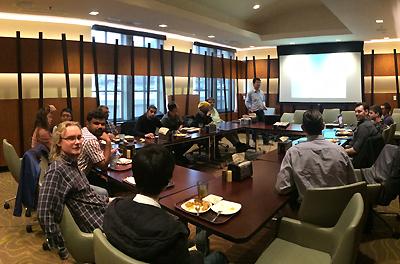Home
Welcome

Our scientific interests encompass different branches of soft condensed matter and optical physics, including novel laser trapping and imaging techniques, molecular and colloidal self-assembly, fundamental properties of liquid crystals, polymers, nano-structured and other functional materials, as well as their photonic and electro-optic applications. The emerging scientific frontiers in these fields show an exceptional promise of significant new discovery and of new applications that become possible only now, after the recent breakthroughs in condensed matter physics, optics, nanoscience, and biology.

Liquid crystals, nano-structured, biomolecular, and other soft materials are attractive not only because of the richness of observed physics phenomena but also because of the wealth of potential technological applications and because of their significance for the fields of biology, biotechnology, and medicine. These materials combine properties of crystalline solids and ordinary liquids in unexpected ways, often possessing fluidity along with orientational order and varying degrees of positional order.

The constituent molecules (or particles and other building blocks) of soft matter interact via many different types of interactions, ranging from van der Waals interactions, to screened electrostatic and steric interactions, and to specific chemical binding. However, the interactions are usually weak and comparable in strength to thermal fluctuations. Therefore, these relatively fragile forms of matter easily respond to mechanical stresses, electric and magnetic fields, temperature variations, presence of ions, optical fields of focused laser beams, etc. Often pocessing birefringence, optical activity, and self-organized structures with periodicity in the nanometer and micrometer ranges, these materials can be used to deflect laser beams in telecommunications and to visualize information in displays.

At the same time, light (in a form of focused laser beams) can be used to control these materials by shaping patterns of molecular orientations, optical trapping of colloidal particles and defects, manipulation of bacteria and single moleculaes. Even though scientists and engineers have learned how to use some of the unique properties of soft materials only recently, their properties have always been of pivoit importance in nature. For example, the potential for technological applications of photonic crystals has been broadly recognized less than two decades ago. At the same time, photonic structures are ubiquitous in nature and have been developed, for example, in butterflies and beetles during their evolution. Clearly, these materials have enormous potential but require thorough understanding of underpinning physics phenomena. We are interested to study the ordered states of soft materials and biological systems from the fundamental science standpoint as well as for applications ranging from novel technologies to treatment of diseases. These scientific interests also stem from the need to decipher the physical mechanisms behind molecular self-organization and interactions between nanoparticles, biological molecules, and living cells. Our research may impinge on understanding of important biological processes and will be pursued in parallel with development of novel devices and technologies based on nano-structured soft and biomolecular materials.
For examples of past work, see our Publications page. For a list of ongoing projects, see our Research page.
We are affiliated with the Department of Physics, the Soft Materials Research Center, Renewable and Sustainable Energy Institute, and CU Biophysics Supergroup and Program, University of Colorado at Boulder.
We are also affiliated with the Materials Science Engineering Program and the Department of Electrical, Computer, and Energy Engineering.
Our Laboratory is part of the University of Colorado Satellite of the WPI-SKCM2.













